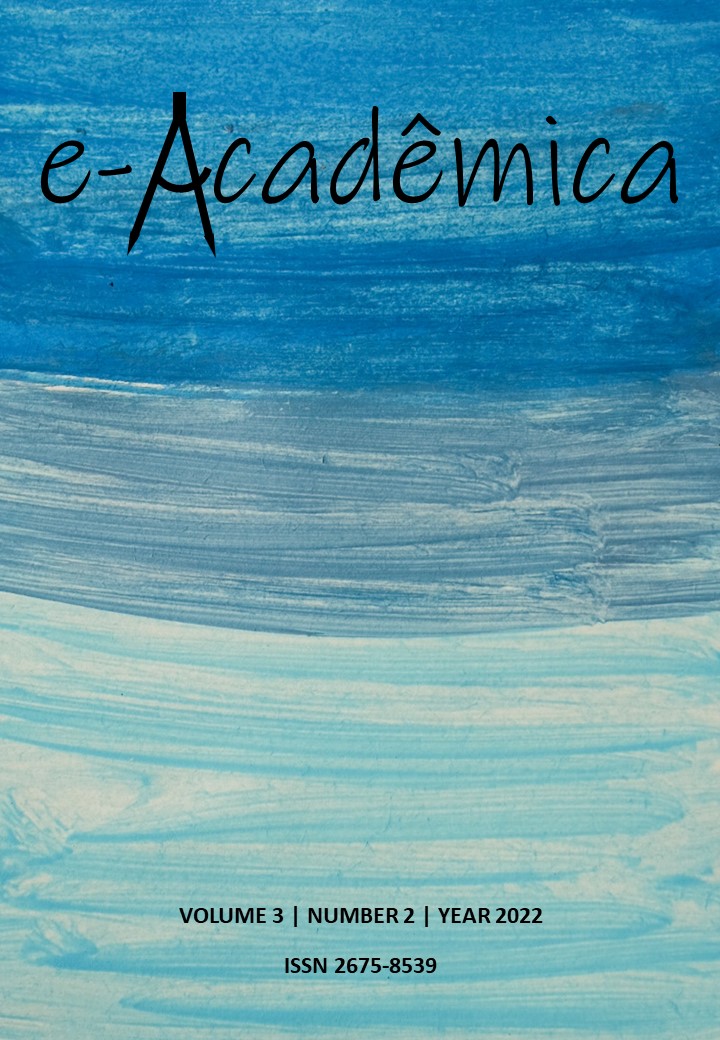Simple transposition flap for closure of nasal surgical defect: case report
DOI:
https://doi.org/10.52076/eacad-v3i2.219Keywords:
Basal cell carcinoma; Simple transposition; Surgical flaps and wound.Abstract
The nose is the organ of the apparatus that has essential importance in the phenotypic characterization of the individual. The resection of skin tumors and the occurrence of trauma are the most urgent causes of nasal surgery. Having a small redundancy of tissue in the nasal region, the cut cuts are often performed to close operational operations, and can be classified according to the movement performed to close the region used: rotation or advance interpolation, which can be performed for closure or advance interpolation. Simple transposition flaps are those that, with only one additional lobe, change the skin force axis, promoting the closure of the defect. It is performed in a single operating time and provides a good concealment of corrections when planned and executed. The patient with a simple recovery surgical device, in relation to basal cell carcinoma and was closed by means of a transposition of a transposed lobe, is used only for closure, without retractions or nasal compromise. We report a case of nasal defect closure. The performance of this flap in this location is unusual, as the nose is an area of little tissue redundancy, which would limit the execution of the technique. Nasal surgical defects are often challenging to reconstruct. Meals are seldom used in this location, they should be thought of as alternatives, but they should be designed as city structures that cannot be designed as city structures and that are not easier to find, but also small units.
References
ESPÓSITO, A. C. C. et al. Retalhos cirúrgicos para fechamento de defeitos faciais síncronos. Surgical & Cosmetic Dermatology, [S. l.], ano 2019, v. 11, p. 160-163, 6 jun. 2019.
FRAGA, D. S., LIMA, V. S., SILVEIRA, Á. S., CITRIN, M., MAITO, E. D. M. & SANTOS, F. Z. O uso do retalho de Limberg para reparos de defeitos na face. Rev. Bras. Cir. Plást. v. 27, n. 3, p. 23. 2012.
GON, A. dos S; ARAÚJO, F M. Zetaplastia como alternativa para fechamento de defeito cirúrgico duplo. Surgical & Cosmetic Dermatology, Sociedade Brasileira de Dermatologia, Rio de janeiro, ano 2015, v. 7, 23 maio 2015. 2, p. 162-164.
MACHADO, W. A.; & PESSOA, S. G. P. Prevalência das técnicas de reconstrução nasal utilizadas nos últimos quatro anos em serviço de Cirurgia Plástica do Ceará. Rev. Bras. Cir. Plást. v. 31, n. 4, p. 491-495. 2016.
MOORE, K. L. et al. Anatomia orientada para a clínica 8ed. – Rio de Janeiro: Guanabara Koogan, 2019. ISBN 978-85-277-3459-2.
TOWNSEND, C. M. Sabiston tratado de cirurgia: A base biológica da prática cirúrgica moderna. 19.ed. Ed.Elsevier. 2014.
Siqueira H. et al. XXXI CONGRESSO BRESILEIRO DE CIRURGIA DERMATOLÓGICA, 2019, Rio de Janeiro. Retalho de transposição nasolabial do tipo monolobado para fechamento em um único estágio de defeito cirúrgico em sulco alar [...]. [S. l.: s. n.], 2019. 168-1.
TISSIANI, L. A. L.; ALONSO, N.; CARNEIRO, M. H.; BAZZI, K.; & Rocco M. Versatilidade do retalho bilobado. Rev. Bras. Cir. Plást. v. 26, n. 3, p. 411-417. 2011.
Limberg A A. Design of local flaps. In: Gibson T, ed. Modern trends in plastic surgery. 2 ed. London: Butterworth-Heinemann; 1966. p. 38-61.
PEREIRA C S, BOTERO E B, REIS G C N dos, & OTA F S. Reconstruction of two defects on the face close to each other: reports of two cases. Surg Cosmet Dermatol. 2016;8(4 Supl. 1):S64-6.
DELUCA J, TAPPEINER L, PICHLER M, & EISENDLE K. Using the Peng flap for a wide dorsal nasal defect. J Dtsch Dermatol Ges. 2014;12(11):1060-2.
SALGARELLI A C, BELLINI P, MULTINU A, MAGNONI C, FRANCOMANO M, FANTINI F, et al. Reconstruction of Nasal Skin Cancer Defects with Local Flaps. J Skin Cancer. 2011:181093.
REDONDO P, BERNAD I, MORENO E, & IVARS M. Elongated Dorsal Nasal Flap to Reconstruct Large Defects of the Nose. Dermatol Surg. 2017;43(8):1036-41.
JENA A, GANGASANI R, REDDY N R, & PATNAYAK R. Reconstruction with Dorsal Nasal Flap after Excision of Basal Cell Carcinoma of the Nose. J Cutan Aesthetic Surg. 2017;10(1):54-5.
STEIGER J D. Bilobed Flaps in Nasal Reconstruction. Facial Plast Surg Clin North Am. 2011;19(1):107–11.
MOLE R J, & BADRI T. Flaps , Bilobed. StatPearls [Internet]. 2018;
HIKAGE S, ONO I, YAMASHITA T, KIMURA T. Three cases of reconstruction with a simply designed bilobed flap after excision of squamous cell carcinomas of the lateral eyebrow areas. J Dermatol. 2014;41(5):399–402.
Hansen JP, & Albertini JG. Trilobed Flap Reconstruction for Distal Nasal Skin Defects. Am Soc Dermatologic Surgery, Inc. 2010;36:1726–35.
CABRAL A R, ALONSO N, BRINCA A, VIEIRA R, & FIGUEIREDO A. Earlobe reconstruction by the Gavello technique and bilobed flap. An Bras Dermatol. 2013;88(2):272–5.
ROHRER T E, & BHATIA A. Transposition flaps in cutaneous surgery. Am Soc Dermatologic Surgery, Inc. 2005;31:1014–23.
Downloads
Published
How to Cite
Issue
Section
License
Copyright (c) 2022 Ana Cláudia Cavalcante Esposito ; Nathália Mizukava Ávila de Robertis; Maria Gabriela Santos Rodrigues; Crystian Bitencourt Soares de Oliveira

This work is licensed under a Creative Commons Attribution 4.0 International License.
Autores que publicam nesta revista concordam com os seguintes termos:
1) Autores mantém os direitos autorais e concedem à revista o direito de primeira publicação, com o trabalho simultaneamente licenciado sob a Licença Creative Commons Attribution que permite o compartilhamento do trabalho com reconhecimento da autoria e publicação inicial nesta revista.
2) Autores têm autorização para assumir contratos adicionais separadamente, para distribuição não-exclusiva da versão do trabalho publicada nesta revista (ex.: publicar em repositório institucional ou como capítulo de livro), com reconhecimento de autoria e publicação inicial nesta revista.
3) Autores têm permissão e são estimulados a publicar e distribuir seu trabalho online (ex.: em repositórios institucionais ou na sua página pessoal) a qualquer ponto antes ou durante o processo editorial, já que isso pode gerar alterações produtivas, bem como aumentar o impacto e a citação do trabalho publicado.










